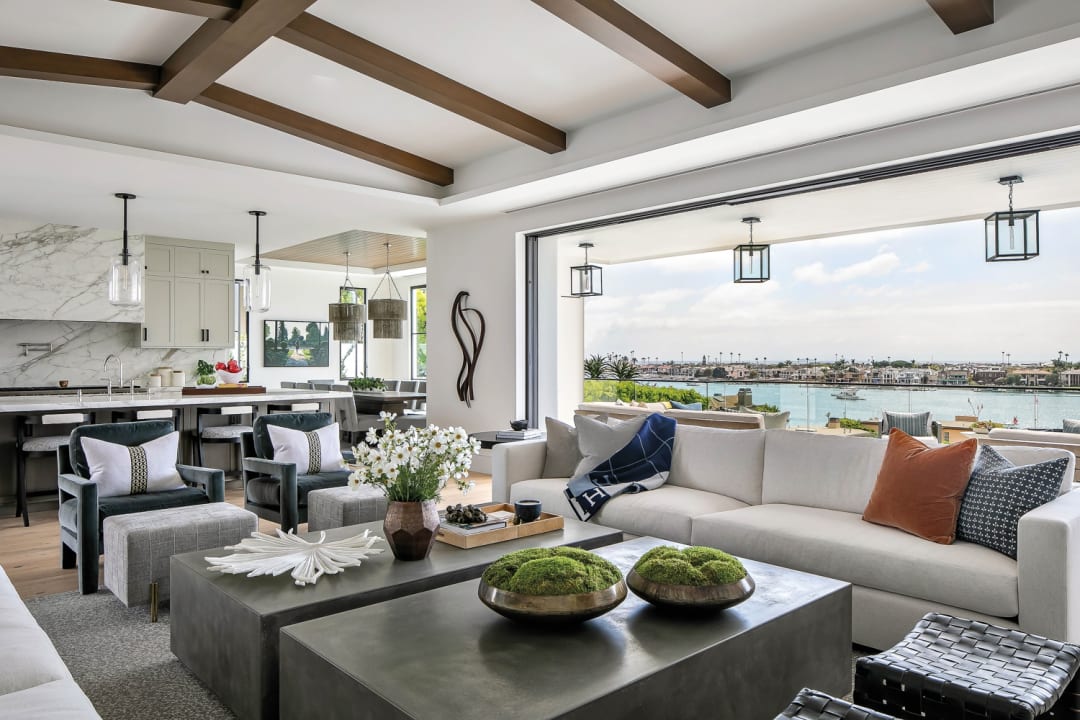Successful design projects are built on teamwork, trust and taking chances. For these homeowners with two adult daughters, swapping out their more traditional Cape Cod home for a ground-up Corona del Mar residence was an opportunity to jump out of their comfort zone, the wife says. The expansive lot they purchased overlooking Newport Harbor was ready to welcome a 7,500-square-foot home drawn up by residential designer Geoff Sumich, and the couple tapped interior designers Rachel Azzolina and Wendy Blackband of Blackband Design, who had helped rework spaces in their previous abode, to tailor the layout and look to their taste.
The architecture references East Coast beach style with a touch of farmhouse charm. “I wanted to give the front façade plenty of character and dimension,” Sumich explains, pointing out the textural movement between board-and-batten siding, steel elements and brick. He also made the most of the home’s hillside perch, designing a glassy two-story rear section that takes full advantage of ocean, beach and harbor views.
For Azzolina and Blackband, the objective was to build upon and elevate Sumich’s vision—“a great foundation,” Azzolina notes—for their discerning clients. “They’re sophisticated and very tuned in to design, so they brought a lot to the table themselves,” Blackband shares. The couple, in fact, arrived with a notebook of ideas and a wish list, getting involved “right down to the raw electrical,” the husband quips. Explains the wife, “We really wanted to do something more contemporary, but nothing stark or cold.” This receptiveness to shaking things up proved key to a great partnership between clients and designers. “We didn’t want another ‘modern farmhouse,’ though they liked that style. We wanted to move it forward and give it a twist,” Blackband comments. Adds Azzolina, “We mixed in contemporary finishes and textures, textiles and patterns, but nothing too crazy or too bold that they might tire of eventually.”
To achieve this goal, the designers filled the home with pieces scaled specifically to fit larger spaces like the main floor’s great room. Meanwhile, antiques and accessories lend “a dynamic touch to the home’s polished, clean edges,” Azzolina says. “We set the foundation with neutrals and highlighted natural materials, then added color and pattern through fabrics, artwork from our clients’ collection, and accessories that can easily be switched out and updated over time.” And as the home is oriented outward, the interior palette pulls from coastal blues and sandy hues.
Attention to the finishes was instrumental to curating a bespoke look, the designers note. For instance, variations in the great room’s ceilings help delineate its different sections, with exposed beams stretching across the living area, tongue-and-groove rift-sawn white oak paneling defining the dining space, and a dropped ceiling crowning the kitchen. There’s also an office—perhaps the moodiest room in the house—with a wood ceiling and paneling. The latter is painted a deep blue-gray shade to offset the white interiors, while the couple’s bedroom suite features hints of warmer shades and natural stone. “Each area has its own personality,” Azzolina states. “And each one, even the outdoors, is designed to feel intimate.” To that end, sliding glass-and-steel doors on both floors allow easy access outside, whether it’s to the lower-level’s pool terrace or the great room’s interior courtyard.
To the homeowners, the surprise lies in how the interiors evolved and how they now utilize their spaces. The courtyard, thoughtfully designed by landscape architect Craig de Pfyffer, has become a regular hangout. And the lower-level entertaining space—which includes a bar, game room and glass-walled wine cellar—exudes magnetic appeal. “It’s amazing how much time we spend down there as opposed to the top floor, which has the best view,” the husband muses. And, the couple notes, because their home continues to change, their relationship with Azzolina and Blackband is ongoing. “This was a fun process,” the wife says. “When you feel as a client that your opinion is appreciated and welcomed, and they help guide you when you start to stray—that’s the sign of a good design team.”


